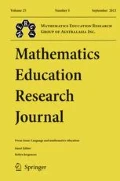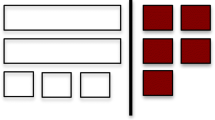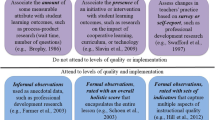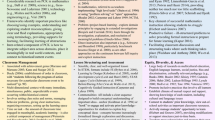Abstract
As part of a teacher professional learning project in mathematics education, university mathematics educators taught demonstration lessons in project primary schools. These lessons were part of a “pre-brief, teaching, and debrief” process, in which up to eight teachers observed each lesson. Using brief questionnaires completed in advance of the lesson, during the lesson, following the debrief, and several weeks later, data were collected on teachers’ intended and actual observation foci and any anticipated changes in their beliefs and practices arising from the experience. There were several common themes in teachers’ intended observations, including a focus on questioning, catering for individual differences, and building student engagement. As evident in other research, teachers’ intended and actual observations gave greater attention to teacher actions and decision making than to student learning and thinking. In this paper, we situate demonstration lessons within teacher professional learning models, describe the features of our model, summarise teacher data, and discuss issues arising from our work.

Similar content being viewed by others
Notes
We acknowledge gratefully the support of the Catholic Education Office (Melbourne), that of Gerard Lewis and Paul Sedunary in particular, in the funding of this research and the professional collegiality of the School Advisers Mathematics (CEOM), the School Mathematics Leaders and teachers, with whom we collaborate in CTLM schools.
References
Ball, D. L., & Bass, H. (2000). Interweaving content and pedagogy in teaching and learning to teach: knowing and using mathematics. In J. Boaler (Ed.), Multiple perspectives on learning and teaching (pp. 83–104). Westport: Ablex.
Ball, D. L., Thames, M. H., & Phelps, G. (2008). Content knowledge for teaching: what makes it special? Journal of Teacher Education, 59, 389–407.
Bazeley, P. (2007). Qualitative data analysis with NVivo. London: Sage.
Borko, H., Jacobs, J., Eiteljorg, E., & Pittman, M. E. (2008). Video as a tool for fostering productive discussions in mathematics professional development. Teaching and Teacher Education, 24, 417–436.
Boyle, B., Lamprianou, I., & Boyle, T. (2005). A longitudinal study of teacher change: what makes professional development effective? Report of the second year of the study. School Effectiveness and School Improvement, 16(1), 1–27.
Bruce, C. D., Ross. J., Flynn, T., & McPherson, R. (2009). Lesson study and demonstration classrooms: Examining the effects of two models of teacher professional development. http://www.tmerc.ca/digitalpapers/samples/WholeResearchStory.pdf. Accessed: 26 August 2011
Butler, D. L., Lauscher, H. N., Jarvis-Selinger, S., & Beckingham, B. (2004). Collaboration and self regulation in teachers’ professional development. Teaching and Teacher Education, 20, 435–455.
Clarke, D. M. (1994). Ten key principles from research for the professional development of mathematics teachers. In D. B. Aichele & A. F. Croxford (Eds.), Professional development for teachers of mathematics (56th yearbook of the national council of teachers of mathematics) (pp. 37–48). Reston: NCTM.
Clarke, D. M., & Clarke, B. A. (2004). Mathematics teaching in grades k-2: painting a picture of challenging, supportive, and effective classrooms. In R. N. Rubenstein & G. W. Bright (Eds.), Perspectives on the teaching of mathematics (66th yearbook of the national council of teachers of mathematics) (pp. 67–81). Reston: NCTM.
Clarke, D., & Hollingworth, H. (2002). Elaborating a model of teacher professional growth. Teaching and Teacher Education, 18, 947–967.
Corbin, J., & Strauss, A. L. (2008). Basics of qualitative research: grounded theory procedures and techniques (3rd ed.). Thousand Oaks: Sage.
Creswell, J. W. (2007). Qualitative inquiry and research design: choosing among five approaches (2nd ed.). Thousand Oaks: Sage.
Davis, N., & Walker, K. (2005). Learning to notice: one aspect of teachers’ content knowledge in the numeracy classroom. In P. Clarkson, A. Downton, D. Gronn, M. Horne, A. McDonough, R. Pierce, & A. Roche (Eds.), Building connections: theory, research and practice (Proceedings of the 28th annual conference of the Mathematics Education Research Group of Australasia, vol. 1) (pp. 273–280). Sydney: MERGA.
Feuerstein, A. (2000). School characteristics and parent involvement: influences on participation in children’s schools. The Journal of Educational Research, 94(1), 29–39.
Fernandez, C. (2005). Lesson study: a means for elementary teachers to develop the knowledge of mathematics needed for reform-minded teaching? Mathematical Thinking and Learning, 7(4), 265–289.
Fernandez, C., Cannon, J., & Chokshi, S. (2003). A US–Japan lesson study collaboration reveals critical lenses for examining practice. Teaching and Teacher Education, 19, 171–185.
Ghousseni, H., & Sleep, L. (2011). Making practice studyable. ZDM Mathematics Education, 42(1), 147–160.
Goldsmith, L. T., Doerr, H., & Lewis, C. (2009). Opening the black box of teacher learning: Shifts in attention. In M. Tzekaki, M. Kaldrimidou, & H. Sakonidis (Eds.), In search of theories in mathematics education (Proceedings of the 33rd annual conference of the International Group of Psychology of Mathematics Education, vol. 1) (pp. 97–104). Thessaloniki: PME.
Goldin, G. A., & Shteingold, N. (2001). Systems of representations and the development of mathematical concepts. In A. Cuoco & F. Curcio (Eds.), The roles of representation in school mathematics (pp. 1–23). Reston: National Council of Teachers of Mathematics.
Grierson, A. L., & Gallagher, T. L. (2009). Seeing is believing: creating a catalyst for teacher change through a demonstration classroom professional development initiative. Professional Development in Education, 35(4), 567–584.
Guskey, T. R. (1986). Staff development and the process of teacher change. Educational Researcher, 15(5), 5–12.
Higgins, J., & Parsons, R. (2009). A successful professional development model in mathematics. Journal of Teacher Education, 60(3), 231–242.
Joyce, B., & Showers, B. (1980). Improving inservice training: the messages of research. Educational Leadership, 37(5), 379–385.
Lewis, C. (2002). Lesson study: a handbook of teacher-led instructional change. Philadelphia: Research for Better Schools.
Lewis, C., Perry, R., & Hurd, J. (2004). A deeper look at lesson study. Educational Leadership, 62(5), 18–23.
Loucks-Horsley, S., Love, N., Stiles, K. E., Mundry, S., & Hewson, P. W. (2003). Designing professional development for teachers of science and mathematics. Thousand Oaks: Sage.
McDonough, A., & Clarke, D. M. (2003). Describing the practice of effective teachers of mathematics in the early years. In N. A. Pateman, B. J. Dougherty, & J. T. Zilliox (Eds.), Proceedings of the 2003 joints meeting of the international group for the psychology of mathematics education and the psychology of mathematics education group North America (vol. 3) (pp. 261–268). Hawaii: University of Hawaii.
Miles, M. B., & Huberman, A. M. (1994). Qualitative data analysis (2nd ed.). Thousand Oaks: Sage.
Putman, J. (1985). Perceived benefits and limitations of teacher educator demonstration lessons. Journal of Teacher Education, 36, 36–41.
Rowe, M. B. (1974). Wait-time and rewards as instructional variables, their influence on language, logic, and fate control: part one—wait time. Journal of Research in Science Teaching, 11(2), 81–94.
Saphier, J., & West, L. (2010). How coaches can maximise student learning. Phi Delta Kappan, 91(4), 46–50.
Shulman, L. (1986). Those who understand: knowledge growth in teaching. Educational Researcher, 15(2), 4–14.
Sullivan, P. (2011). Teaching mathematics: using research-informed strategies (Australian Education Review, 59). Camberwell: Australian Council for Educational Research.
Takashashi, A., & Yoshida, M. (2004). Ideas for establishing lesson-study communities. Teaching Children Mathematics, 10(9), 436–443.
Tytler, R., Smith, R., Grover, P., & Brown, S. (2006). A comparison of professional development models for teachers of primary mathematics and science. Journal of Teacher Education, 27(3), 193–214.
Van Driel, J. H., & Berry, A. (2012). Teacher professional development focusing on pedagogical content knowledge. Educational Researcher, 41(1), 26–28.
van Es, E. A., & Sherin, M. G. (2008). Mathematics teachers’ “learning to notice” in the context of a video club. Teaching and Teacher Education, 24, 244–276.
West, L., & Curcio, F. R. (2004). Collaboration sites: teacher-centred professional development in mathematics. Teaching Children Mathematics, 10(5), 268–273.
White, A. L., & Southwell, B. (2003). Lesson study: a model of professional development for teachers of mathematics in years 7 to 12. In L. Bragg, C. Campbell, G. Herbert, & J. Mousley (Eds.), Mathematics education research: Innovation, networking, opportunity (Proceedings of the 26th annual conference of the Mathematics Education Research Group of Australasia, Vol. 2) (pp. 744–751). Pymble: MERGA.
Yan, W., & Lin, Q. (2005). Parent involvement and mathematics achievement: contrast across racial and ethnic groups. The Journal of Educational Research, 99(2), 116–127.
Author information
Authors and Affiliations
Corresponding authors
Appendix
Appendix
Appendix 1: demonstration lesson teacher proforma

Rights and permissions
About this article
Cite this article
Clarke, D., Roche, A., Wilkie, K. et al. Demonstration lessons in mathematics education: teachers’ observation foci and intended changes in practice. Math Ed Res J 25, 207–230 (2013). https://doi.org/10.1007/s13394-012-0058-z
Received:
Revised:
Accepted:
Published:
Issue Date:
DOI: https://doi.org/10.1007/s13394-012-0058-z




